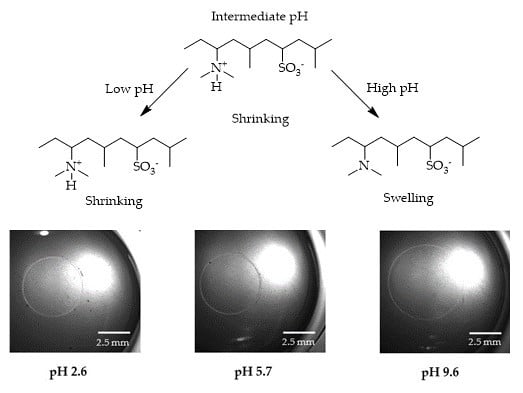pH- and Metal Ion- Sensitive Hydrogels based on N-[2-(dimethylaminoethyl)acrylamide]
Abstract
:1. Introduction
2. Materials and Methods
2.1. Synthesis of Hydrogels
2.2. Characterization of Hydrogels
3. Results and Discussion
3.1. pH Sensitivity
3.1.1. Effect of Crosslinking
3.1.2. Effect of Ionizable Monomer
3.2. Metal Ion Sensitivity
3.2.1. Effect of Crosslinking
3.2.2. Effect of the Addition of Acetic Acid on Ionizable Monomer
3.2.3. Effect of Ionizable Monomer on Metal Ion Sensitivity
4. Conclusions
Acknowledgments
Author Contributions
Conflicts of Interest
Abbreviations
| DMAEAAm | N-[2-(dimethylaminoethyl)acrylamide] |
| DMAAm | N,N-dimethylacrylamide |
| AA | Acrylic acid |
| AMPS | 2-acrylamido-2-methyl-1-propanesulphonic acid |
| BIS | N,N-Methylenebisacrylamide |
| PBS | Phosphate-buffered saline |
| Irgacure 2959 | 2-Hydroxy-1-[4-(2-hydroxyethoxy) phenyl]-2-methyl-1-propanone |
References
- Beebe, D.J.; Moore, J.S.; Bauer, J.M.; Yu, Q.; Liu, R.H.; Devadoss, C.; Jo, B.H. Functional hydrogel structures for autonomous flow control inside microfluidic channels. Nature 2000, 404, 588. [Google Scholar] [CrossRef] [PubMed]
- Eddington, D.T.; Liu, R.H.; Moore, J.S.; Beebe, D.J. An organic self-regulating microfluidic system. Lab. Chip 2001, 1, 96. [Google Scholar] [CrossRef] [PubMed]
- Ionov, L. Hydrogel-based actuators: possibilities and limitations. Mater. Today 2014, 17, 494. [Google Scholar] [CrossRef]
- Döring, A.; Birnbaum, W.; Kuckling, D. Responsive hydrogels – structurally and dimensionally optimized frameworks for application in catalysis, micro-system, technology and material science. Chem. Soc. Rev. 2013, 42, 7391. [Google Scholar] [CrossRef] [PubMed]
- Katchalsky, A.; Michaeli, I. Polyelectrolyte gels in salt solutions. J. Polym. Sci. 1955, 15, 69. [Google Scholar] [CrossRef]
- Brannon-Peppas, L.; Peppas, N.A. Equilibrium swelling behavior of pH-sensitive hydrogels. Chem. Eng. Sci. 1991, 46, 715. [Google Scholar] [CrossRef]
- Oppermann, W. Polyelectrolyte gels. In Proceedings of the ACS Symposium Series No. 480, Washington, DC, USA, August 1990; American Chemical Society: Washington, DC, USA, 1992; p. 159. [Google Scholar]
- Siegel, R.A.; Firestone, B.A. pH-dependent equilibrium swelling properties of hydrophobic polyelectrolyte copolymer gels. Macromolecules 1988, 21, 3254. [Google Scholar] [CrossRef]
- Cornejo-Bravo, J.M.; Siegel, R.A. Water vapour sorption behaviour of copolymers of N,N-diethylaminoethyl methacrylate and methy methacrylate. Biomaterials 1996, 17, 1187. [Google Scholar] [CrossRef]
- Bashir, R.; Hilt, J.Z.; Elibol, O.; Gupta, A.; Peppas, N.A. Micromechanical cantilever as an ultrasensitive pH microsensor. Appl. Phy. Lett. 2002, 81, 3091. [Google Scholar] [CrossRef]
- Liu, R.H.; Yu, Q.; Beebe, D.J. Fabrication and characterization of hydrogel-based microvalves. J. Microelectromech. Syst. 2002, 11, 45. [Google Scholar] [CrossRef]
- Yajima, Y.; Yamada, M.; Yamada, E.; Iwase, M.; Seki, M. Facile fabrication processes for hydrogel-based microfluidic devices made of natural biopolymers. Biomicrofluidics 2014, 8, 024115. [Google Scholar] [CrossRef] [PubMed]
- Tanaka, T. Collapse of gels and the critical endpoint. Phys. Rev. Lett. 1978, 40, 820. [Google Scholar] [CrossRef]
- Hirotsu, S.; Hirokawa, Y.; Tanaka, T. Volume phase transition of ionized N-isopropylacrylamide gels. J. Chem. Phys. 1987, 87, 1392. [Google Scholar] [CrossRef]
- Beltran, S.; Baker, J.P.; Hooper, H.H.; Blanch, H.W.; Prausnitz, J.M. Swelling equilibria for weakly ionizable, temperature-sensitive hydrogels. Macromolecules 1991, 24, 549. [Google Scholar] [CrossRef]
- Taylor, L.D.; Ceranknowski, L.D. Preparation of films exhibiting a balanced temperature dependence to permeation by aqueous solution–A study of lower consolute behavior. J. Polym. Sci. Part A 1975, 13, 2551. [Google Scholar] [CrossRef]
- Prochazka, K.; Matin, T.J.; Webber, S.E.; Munk, P. Onion-type micelles in aqueous media. Macromolecules 1996, 29, 6525. [Google Scholar] [CrossRef]
- Kuckling, D.; Adler, H.-J.P.; Arndt, K.F.; Ling, L.; Habicher, W.D. Temperature and pH dependent solubility of novel poly(N-isopropylacrylamide)-copolymers. Macromol. Chem. Phys. 2000, 201, 273. [Google Scholar] [CrossRef]
- Wang, X.; Ye, G.; Wang, X. Hydrogel diffraction gratings functionalized with crown ether for heavy metal ion detection. Sens. Actuators B 2014, 193, 413. [Google Scholar] [CrossRef]
- Pi, S.-W.; Ju, X.-J.; Wu, H.-G.; Xie, R.; Chu, L.-Y. Smart responsive microcapsules capable of recognizing heavy metal ions. J. Colloid Interface Sci. 2010, 349, 512. [Google Scholar] [CrossRef] [PubMed]
- Luo, Q.; Guan, Y.; Zhang, Y.; Siddiq, M. Lead-sensitive PNIPAM microgels modified with crown ether groups. J. Polym. Sci. Part A 2010, 48, 4120. [Google Scholar] [CrossRef]
- Kuckling, D.; Pareek, P. Synthesis of transition-metal-ion-selective poly(N-isopropylacrylamide) hydrogels by the incorporation of an aza crown ether. J. Polym. Sci. 2003, 41, 1594. [Google Scholar] [CrossRef]
- Mayes, A.G.; Blyth, J.; Millington, R.B.; Lowe, C.R. Metal ion-sensitive holographic sensors. Anal. Chem. 2002, 74, 3649. [Google Scholar] [CrossRef] [PubMed]
- Holtz, J.H.; Hotlz, J.S.; Munro, C.H.; Asher, S.A. Intelligent polymerized crystalline colloidal arrays: novel chemical sensor materials. Anal. Chem. 1998, 70, 780. [Google Scholar] [CrossRef]
- Holtz, J.H.; Asher, S.A. Polymerized colloidal crystal hydrogel films as intelligent chemical sensing material. Nature 1997, 389, 829. [Google Scholar] [CrossRef]
- Bünemann, H.; Dattagupta, N.; Schuetz, H.J.; Müller, W. Synthesis and properties of acrylamide-substituted base pair specific dyes for deoxyribonucleic acid template mediated synthesis of dye polymers. Biochemistry 1981, 20, 2864. [Google Scholar] [CrossRef] [PubMed]
- Gao, M.; Gawel, K.; Stokke, B.T. Polyelectrolyte and antipolyelectrolyte effects in swelling of polyampholyte and polyzwitterionic charge balanced and charge offset hydrogels. Eur. Polym. J. 2014, 53, 65. [Google Scholar] [CrossRef]
- Ihsan, A.B.; Sun, T.L.; Kuroda, S.; Haque, M.A.; Kurokawa, T.; Nakajima, T.; Gong, J.P. A phase diagram of neutral polyampholyte—From solution to tough hydrogel. J. Mater. Chem. B 2013, 1, 4555. [Google Scholar] [CrossRef]
- Masaki, M.; Kokufuta, E. Polyampholyte gels of a cross-linked polyanion or polycation network into which an oppositely charged polyion was immobilized. Colloid Polym. Sci. 2013, 291, 669. [Google Scholar] [CrossRef]
- Cai, Q.Y.; Grimes, C.A. A remote query magnetoelastic pH sensor. Sens. Actuators B 2000, 71, 112. [Google Scholar] [CrossRef]
- Yang, R.; Zompa, L.J. Metal complexes of cyclic triamines. 1. Complexes of 1,4,5-triazacyclononane ([9]aneN3) with nickel (II), copper (II), and zinc (II). Inorg. Chem. 1976, 15, 1499. [Google Scholar] [CrossRef]
- Hilliard, H.M.; Yoke, J.T. Silver(I) complexes of bicyclic tertiary amines. Inorg. Chem. 1966, 5, 57. [Google Scholar] [CrossRef]
- Pearson, R.G. Hard and soft acids and bases. J. Am. Chem. Soc. 1963, 85, 3533. [Google Scholar] [CrossRef]

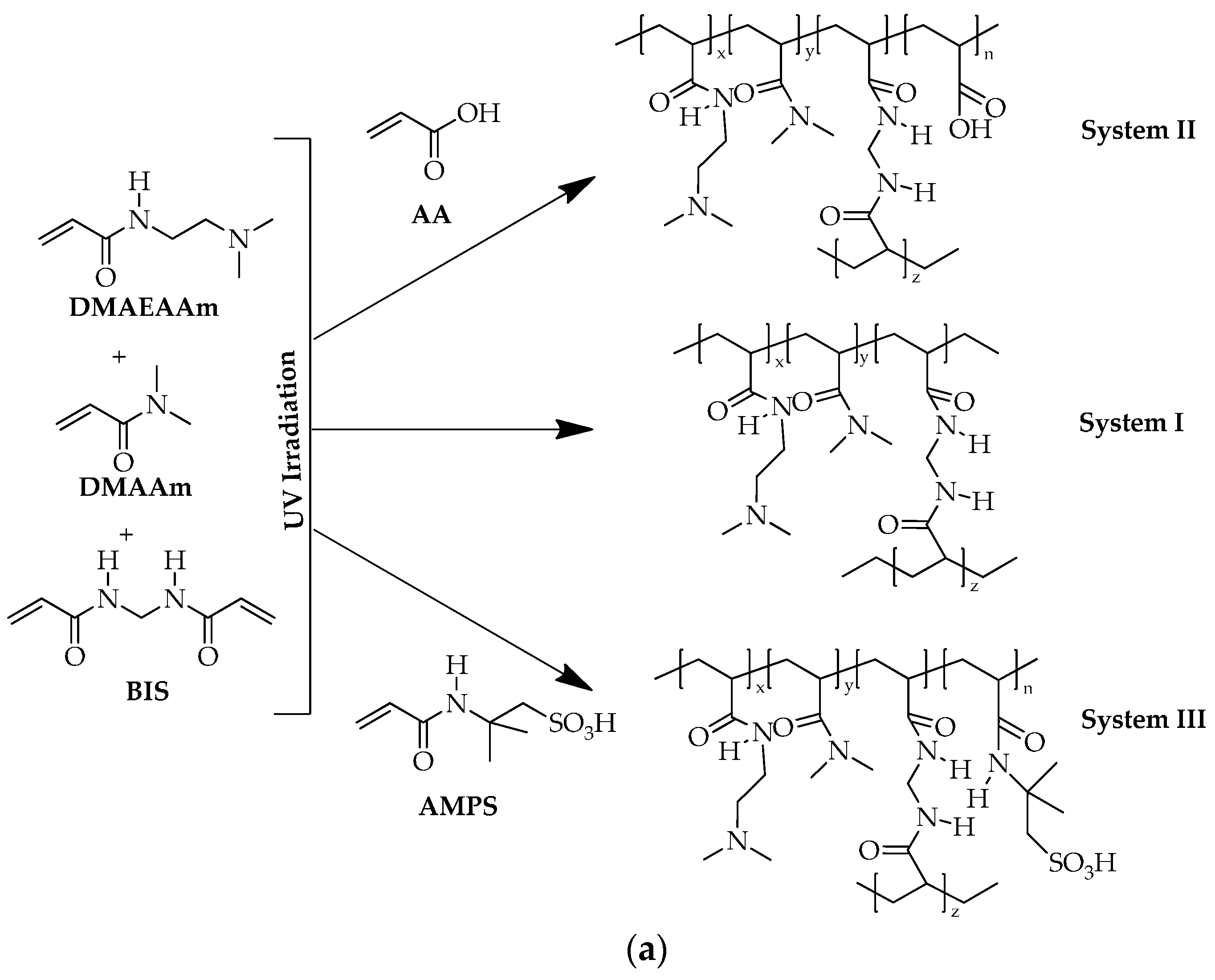
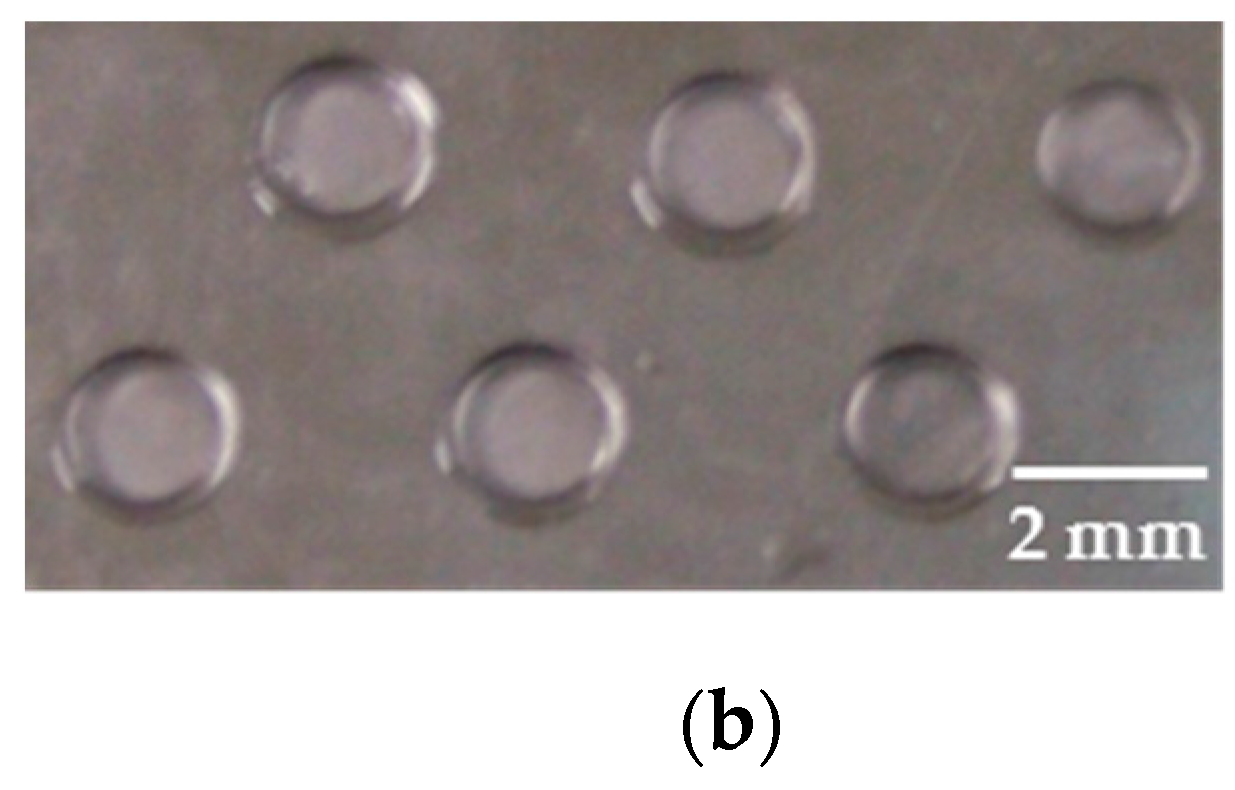
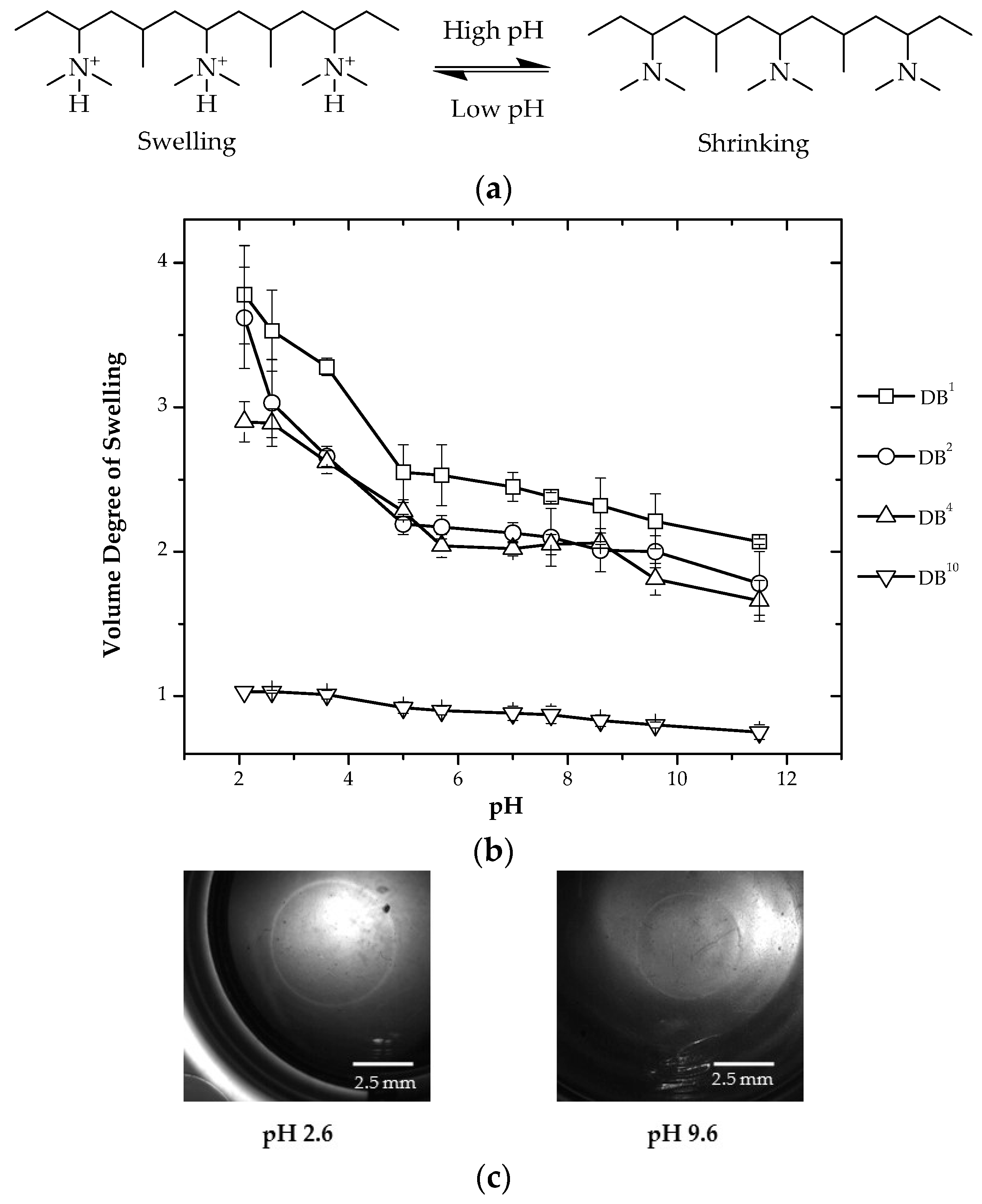
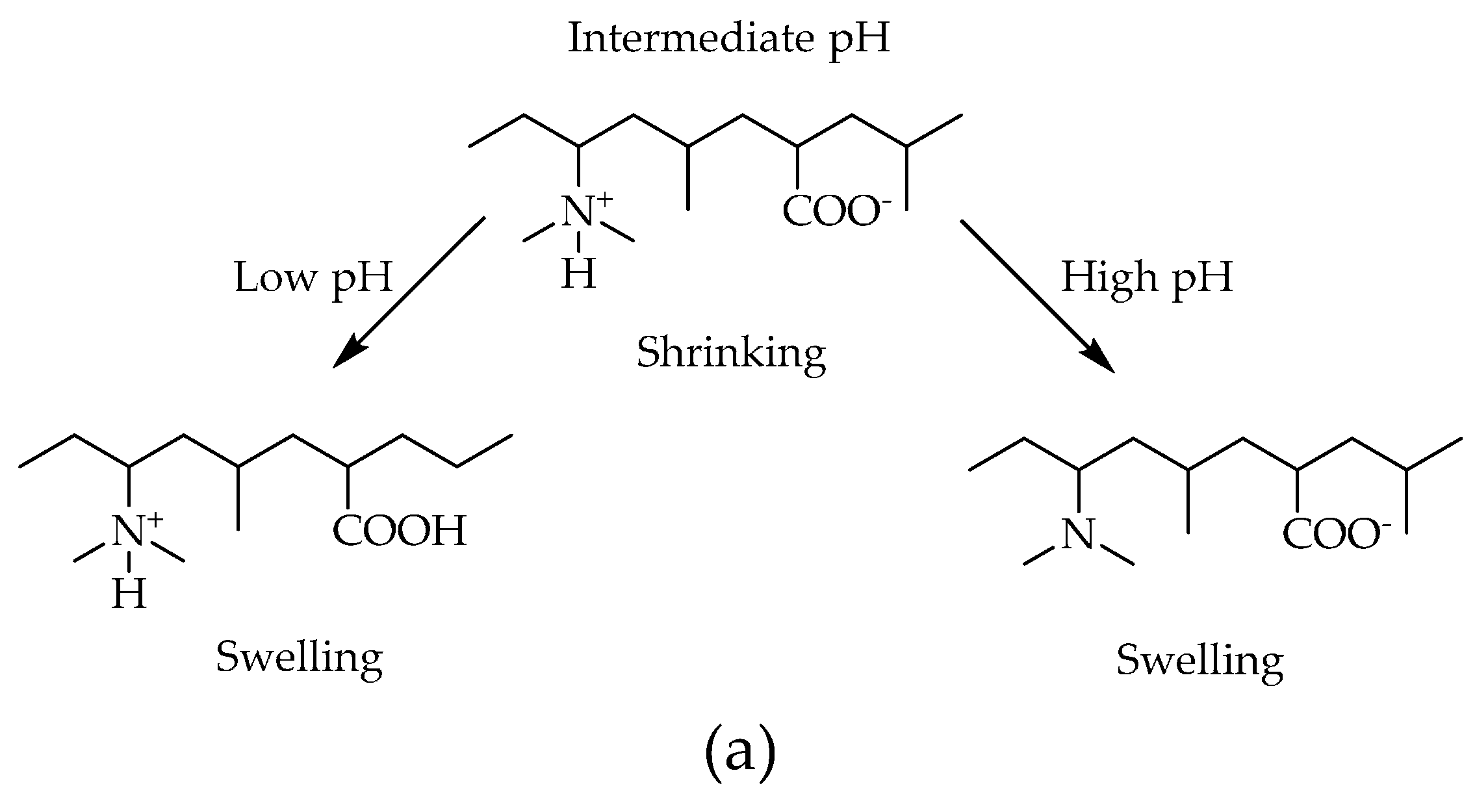

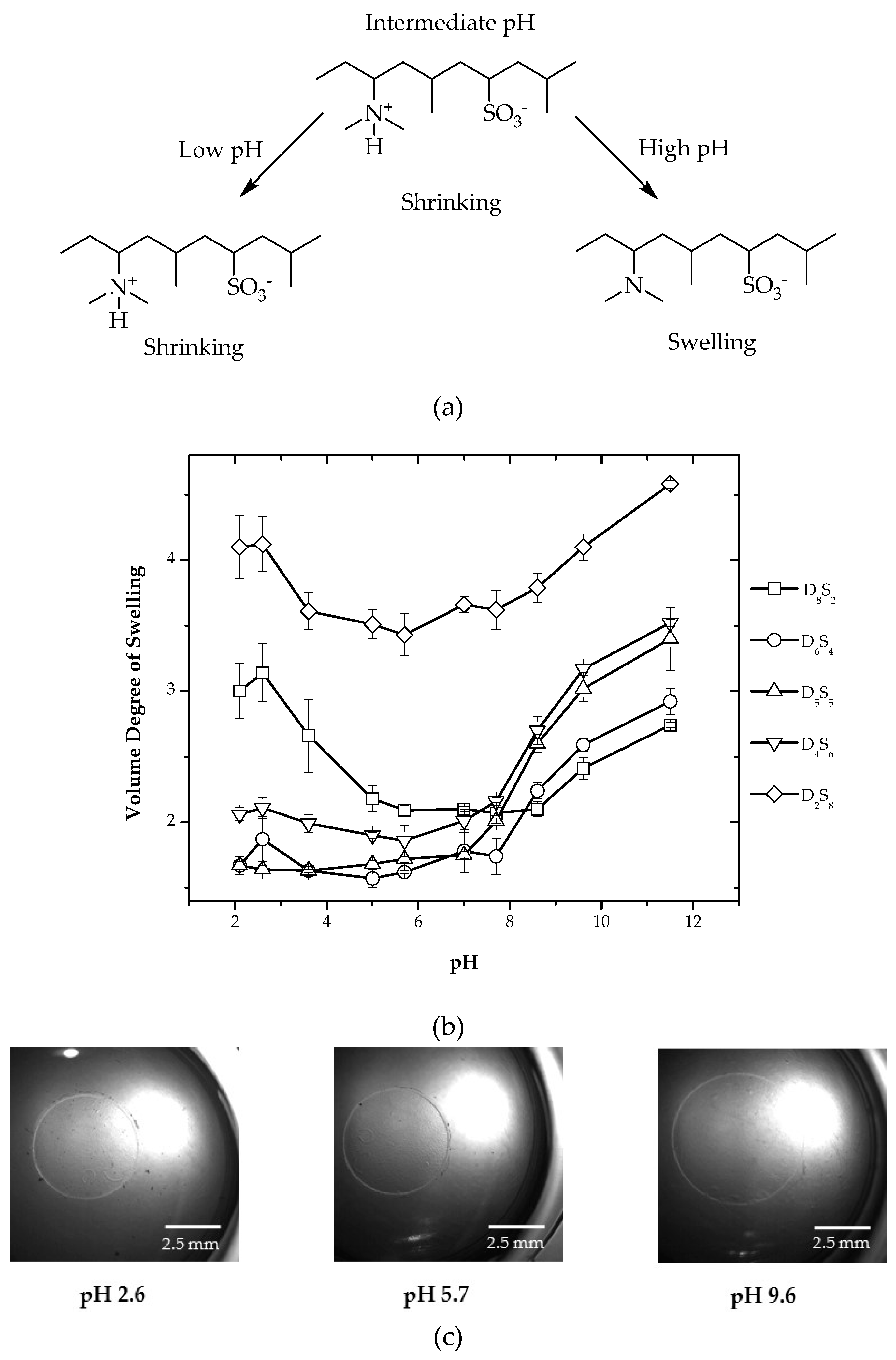
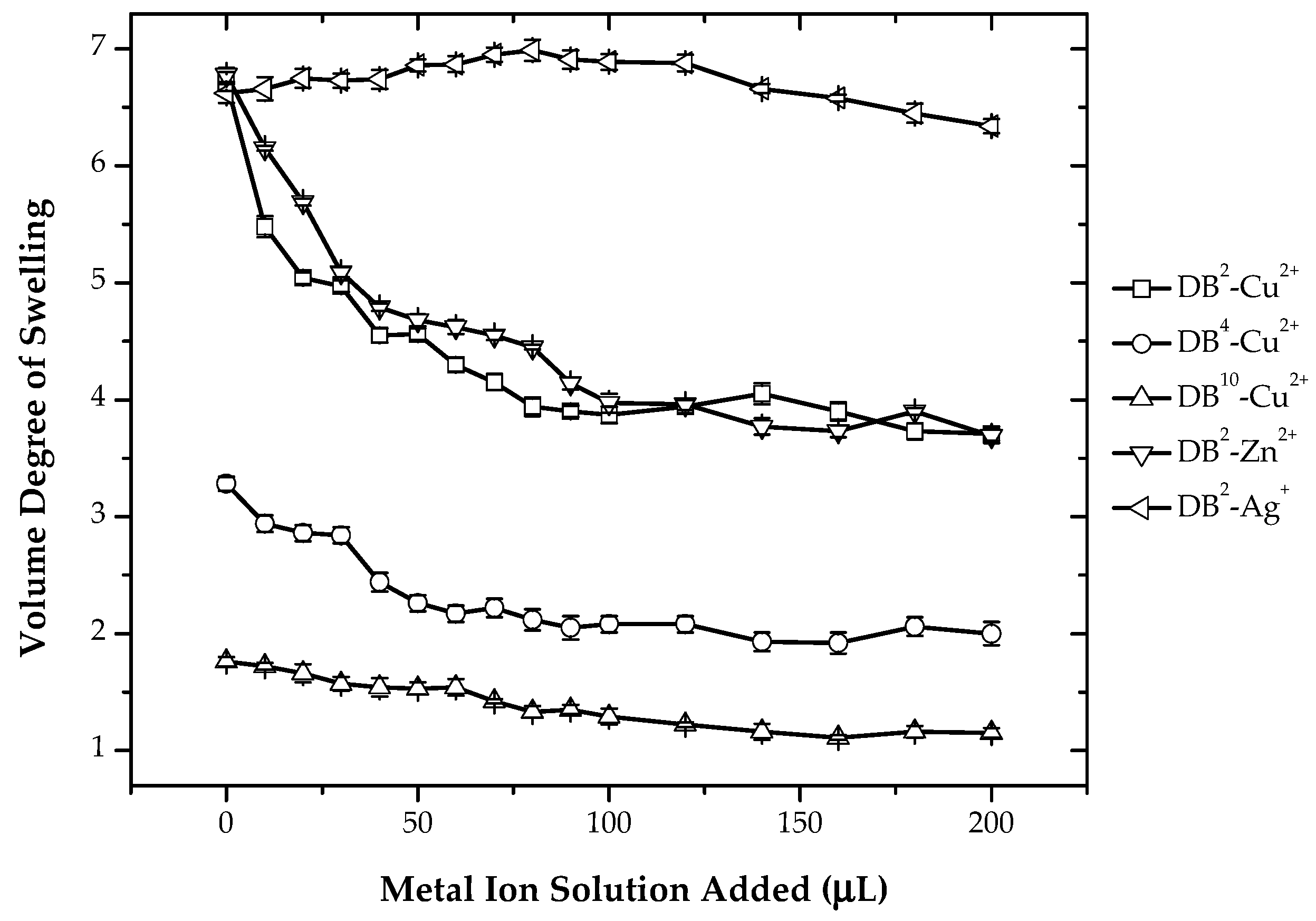

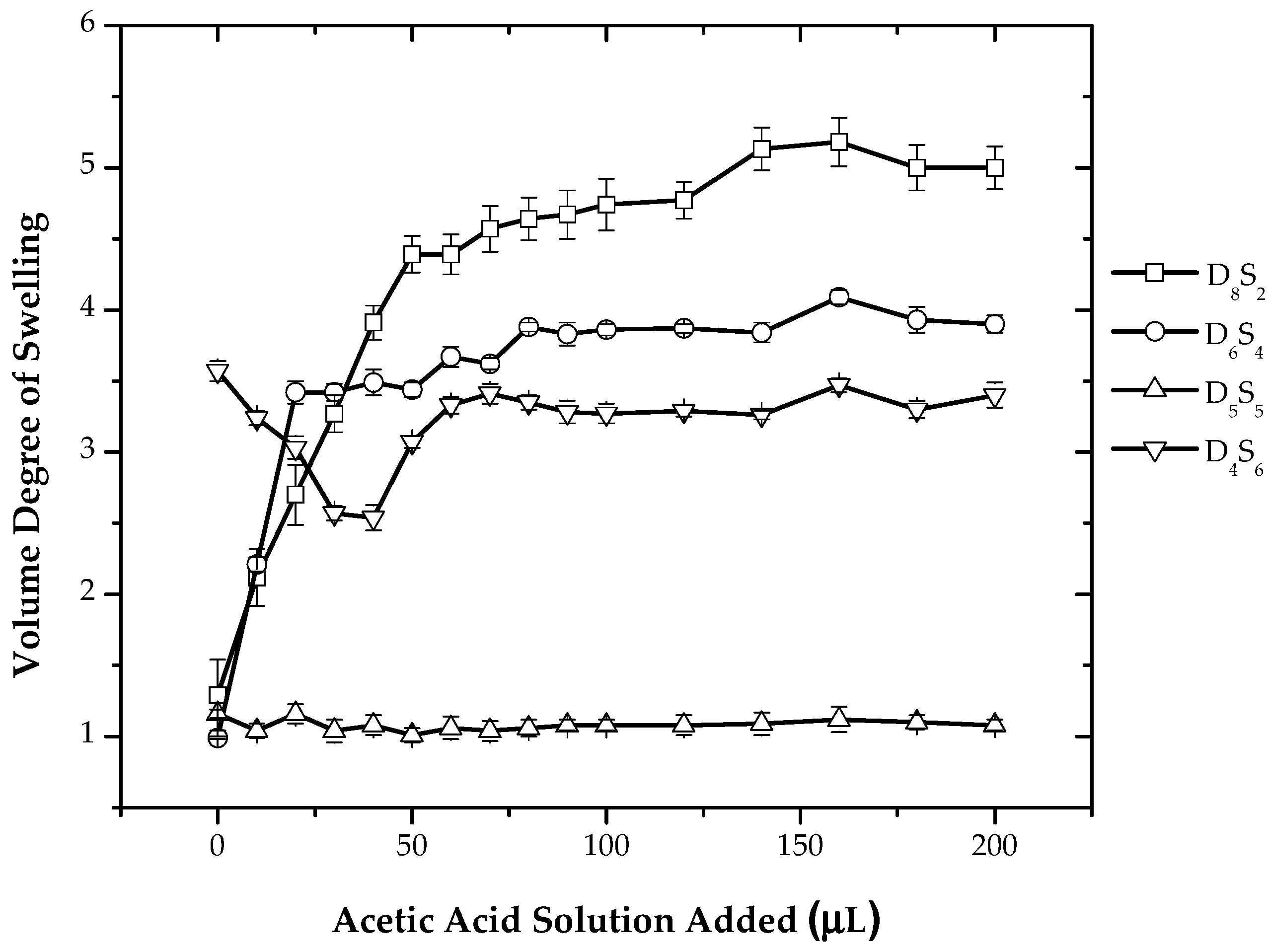
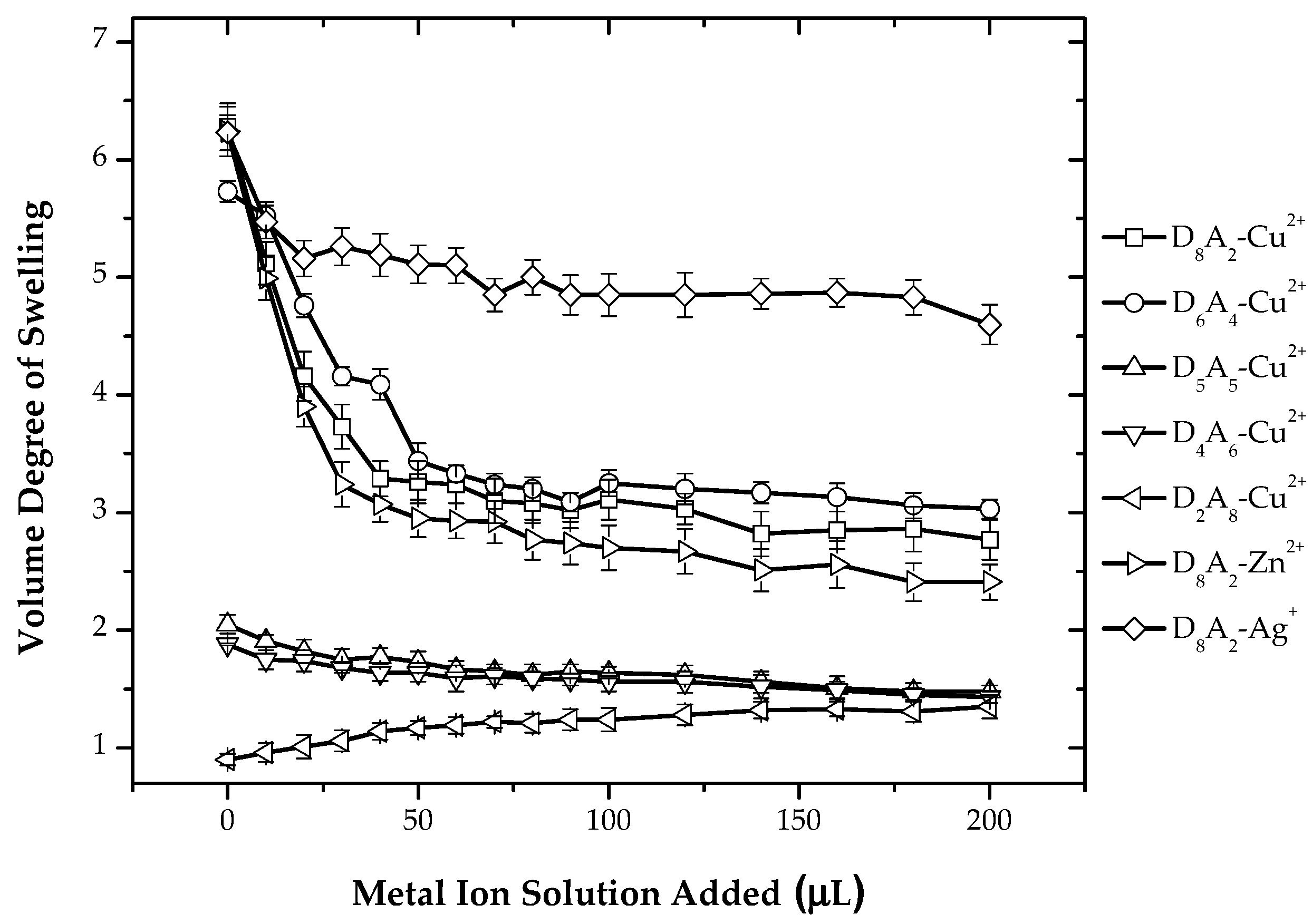
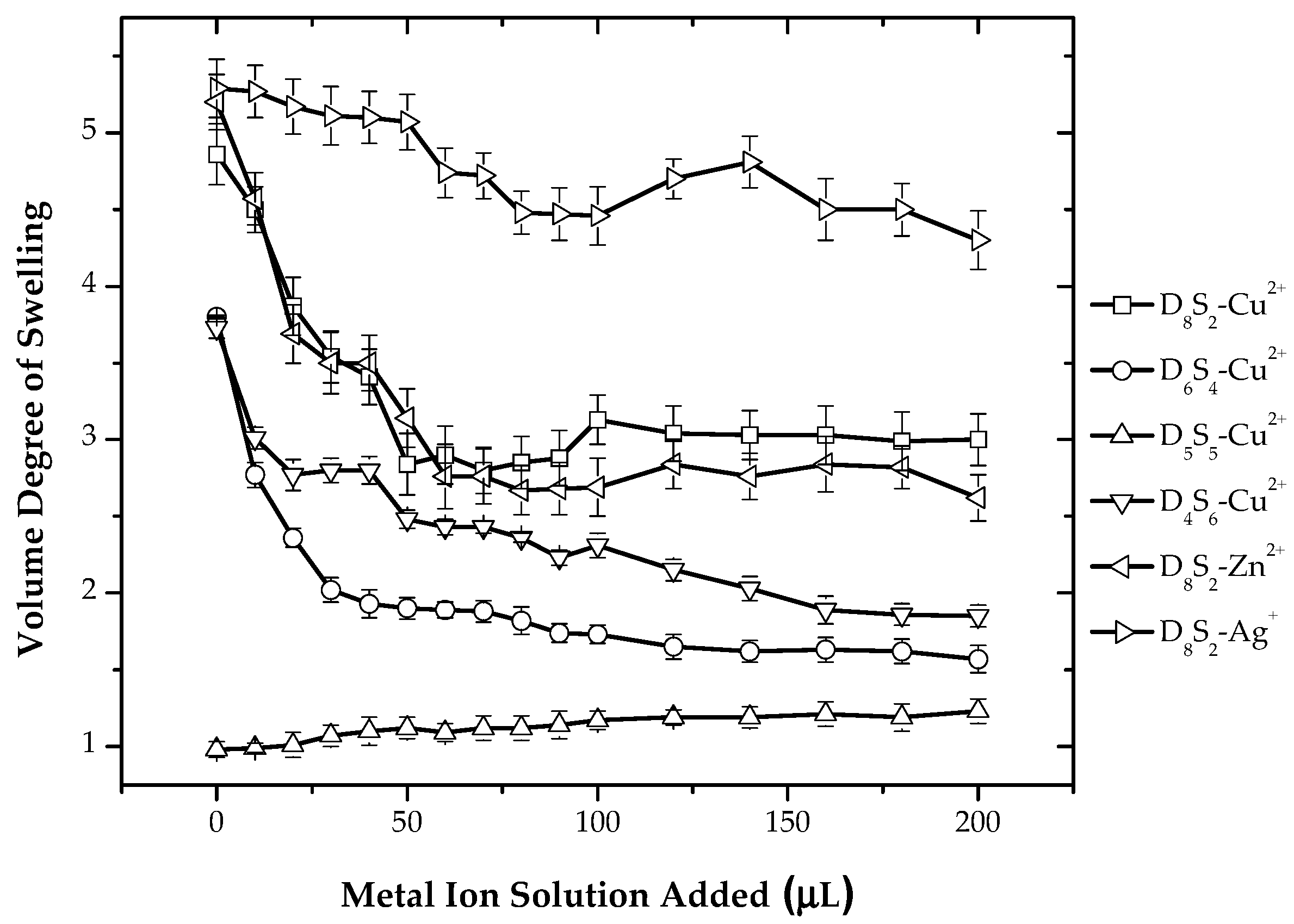
| System I | ||||
|---|---|---|---|---|
| Designation used DB a | DMAEAAm (D) (mmol) | DMAAm (M) (mmol) | BIS (B) (mmol) | |
| DB 1 | 2.5 | 2.5 | 0.05 | |
| DB 2 | 2.5 | 2.5 | 0.1 | |
| DB 4 | 2.5 | 2.5 | 0.2 | |
| DB 10 | 2.5 | 2.5 | 0.5 | |
| System II | ||||
| Designation used DbAc | DMAEAAm (D) (mmol) | AA (A) (mmol) | DMAAm (M) (mmol) | BIS (B) (mmol) |
| D8A2 | 2.0 | 0.5 | 2.5 | 0.1 |
| D6A4 | 1.5 | 1.0 | 2.5 | 0.1 |
| D5A5 | 1.25 | 1.25 | 2.5 | 0.1 |
| D4A6 | 1.0 | 1.5 | 2.5 | 0.1 |
| D2A8 | 0.5 | 2.0 | 2.5 | 0.1 |
| System III | ||||
| Designation used DdSe | DMAEAAm (D) (mmol) | AMPS (S) (mmol) | DMAAm (M) (mmol) | BIS (B) (mmol) |
| D8S2 | 2.0 | 0.5 | 2.5 | 0.1 |
| D6S4 | 1.5 | 1.0 | 2.5 | 0.1 |
| D5S5 | 1.25 | 1.25 | 2.5 | 0.1 |
| D4S6 | 1.0 | 1.5 | 2.5 | 0.1 |
| D2S8 | 0.5 | 2.0 | 2.5 | 0.1 |
© 2016 by the authors. Licensee MDPI, Basel, Switzerland. This article is an open access article distributed under the terms and conditions of the Creative Commons Attribution (CC-BY) license ( http://creativecommons.org/licenses/by/4.0/).
Share and Cite
Nebhani, L.; Choudhary, V.; Adler, H.-J.P.; Kuckling, D. pH- and Metal Ion- Sensitive Hydrogels based on N-[2-(dimethylaminoethyl)acrylamide]. Polymers 2016, 8, 233. https://doi.org/10.3390/polym8060233
Nebhani L, Choudhary V, Adler H-JP, Kuckling D. pH- and Metal Ion- Sensitive Hydrogels based on N-[2-(dimethylaminoethyl)acrylamide]. Polymers. 2016; 8(6):233. https://doi.org/10.3390/polym8060233
Chicago/Turabian StyleNebhani, Leena, Veena Choudhary, Hans-Jürgen P. Adler, and Dirk Kuckling. 2016. "pH- and Metal Ion- Sensitive Hydrogels based on N-[2-(dimethylaminoethyl)acrylamide]" Polymers 8, no. 6: 233. https://doi.org/10.3390/polym8060233
APA StyleNebhani, L., Choudhary, V., Adler, H.-J. P., & Kuckling, D. (2016). pH- and Metal Ion- Sensitive Hydrogels based on N-[2-(dimethylaminoethyl)acrylamide]. Polymers, 8(6), 233. https://doi.org/10.3390/polym8060233






